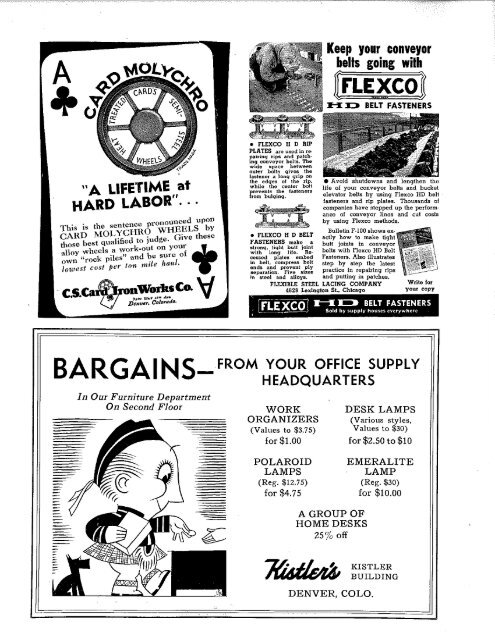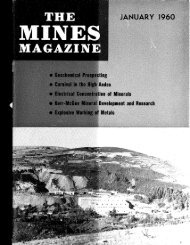M A R C H 1 9 4 0 ^ ^ ^ V O L U M E 30 No. 3 - Mines Magazine
M A R C H 1 9 4 0 ^ ^ ^ V O L U M E 30 No. 3 - Mines Magazine
M A R C H 1 9 4 0 ^ ^ ^ V O L U M E 30 No. 3 - Mines Magazine
You also want an ePaper? Increase the reach of your titles
YUMPU automatically turns print PDFs into web optimized ePapers that Google loves.
"A LIFETIME at<br />
HARD LABOR".<br />
This is f — P-i^als"'S;<br />
£^rbesfSd"to?udre. «ve these<br />
X wheels a work-out on your<br />
own 'Voelc piles" and be sure of<br />
Zwest cost per ton mrle haul.<br />
CS.Ca<br />
ISO'""; J "<br />
Denver. Colorado.<br />
• FLEXCO H D RIP<br />
PLATES are used in repairing<br />
rips and patching<br />
conveyor belts. The<br />
wide space between<br />
outer baits gives the<br />
fastener a long grip on<br />
ttie edges of the rip,<br />
while the center bolt<br />
prevents the fasten era<br />
from bulging.<br />
Keep your conveyor<br />
belts going with<br />
FLEXCO I<br />
BELT FASTENERS<br />
• Avoid shutdowns and lengthen the<br />
life of your conveyor belts and bucket<br />
elevator bells by using Flexco HD belt<br />
fasteners and lip plates. Thousands of<br />
companies have stepped up the performance<br />
of conveyor lines and cut costs<br />
by using Flexco methods.<br />
Bulletin F-lOO shows exactly<br />
how to make tight'<br />
• FLEXCO H D BELT<br />
FASTENERS make a<br />
strong, tight bull joint butt joints in conveyor<br />
with long Hie. Recessed<br />
plates embed Fasteners. Also illustrates<br />
belts with Flexco HD Belt<br />
in belt, compress bell step by step the latest<br />
ends and prevent ply<br />
separation. Five sizes<br />
practice in repairing rips<br />
if. sleel and alloys. and putting in patches.<br />
FLEXIBLE STEEL LACING COMPANY<br />
4628 Lexington St., Chicago<br />
FLEXCO<br />
-X]-_> BELT FASTENERS<br />
Sold by supply houses everywhere<br />
R A P A I Kl ^ FROM YOUR OFFICE SUPPLY<br />
D A M V V J ^ A I I ^ ^ HEADQUARTERS<br />
In Our Furniture Department<br />
On Second Floor WORK<br />
ORGANIZERS<br />
(Values to $3.75)<br />
for $1.00<br />
POLAROID<br />
LAMPS<br />
(Reg. $12.75)<br />
for $4.75<br />
A GROUP OF<br />
HOME DESKS<br />
25% off<br />
DENVER, COLO.<br />
DESK LAMPS<br />
(Various styles,<br />
Values to $<strong>30</strong>)<br />
for $2.50 to $10<br />
EMERALITE<br />
LAMP<br />
(Reg. $<strong>30</strong>)<br />
for $10.00<br />
KISTLER<br />
BUILDING<br />
Mechanization—<br />
(Continued from fage 118)<br />
petroleum, a very large part oi this<br />
coal may never be recovered.<br />
The mercury mines oi the United<br />
States are comparatively unimportant<br />
at present due to the fact that the ore<br />
is rapidly being exhausted. The New<br />
Almaden mine in California was closed<br />
in 1926 for want of ore, although<br />
it had produced between 65 and 75<br />
million dollars worth of mercury and<br />
was the deepest mercury mine in the<br />
world. The New Idria mine, also<br />
in California is at present the greatest<br />
producer in the United States, but<br />
in spite of the application of mechanical<br />
aids in mining, its costs per<br />
unit are increasing.<br />
In general, all of the mineral industries,<br />
where the pinch of increasing<br />
natural handicaps is not yet serious,<br />
show particularly rapid increases<br />
in productivity in the period frora<br />
1919 to 1929 and probably even<br />
greater increases since then. In copper,<br />
iron ore, phosphate rock and<br />
gypsum productivity doubled between<br />
the World War and 1929. In bituminous<br />
coal, the largest of the mineral<br />
industries, the record is one of<br />
steady increase.<br />
Although the Lake Superior district<br />
is the oldest copper camp in the<br />
United States, it is still responsible for<br />
more than 7% oi the U. S. supply.<br />
The effect of mechanization in these<br />
mines is clearly shown by the following<br />
quotation from U. S. B. M. Bui.<br />
<strong>30</strong>6, p. 337, "Along with power drilling,<br />
concentration of haulage, and selective<br />
mining, scraper loading has<br />
been one of the principal economies<br />
that have enabled the Michigan copper<br />
mines to combat the difficulties of<br />
increasing depth and to survive the<br />
competitive struggle."<br />
The graph on page 12 shows how<br />
the yield of copper per ton decreases<br />
with increasing tonnage treated in<br />
spite of improved methods of extraction.<br />
It will be noticed that since<br />
1910 the effect of business depressions<br />
on this curve is to increase the yield<br />
of copper per ton of ore and to decrease<br />
the number of tons treated. In<br />
other words, the number of tons of<br />
ore treated each year depends upon<br />
the price of copper, and the tonnage<br />
curve roughly parallels the price curve,<br />
while the yield per ton curve (or<br />
grade of ore curve) is the reciprocal<br />
of this. Graphs of the other base<br />
metals would be similar to the copper<br />
graph.<br />
While all branches of industry have<br />
tended to grow rapidly in tbe United<br />
States, the mineral industries have developed<br />
faster than any other major<br />
division, far outstripping agriculture<br />
and exceeding even the growth of<br />
manufactures and rail transport. The<br />
following table shows how the growth "<br />
of mineral production from 1899 to<br />
1929 compares with that of population,<br />
agriculture, manufactures and<br />
rail transport.<br />
Percent inrrease<br />
froin 1899<br />
Item LO 1929<br />
Population _._ —- 62%<br />
Agriculture - 48%<br />
Manufactures 210%<br />
Transport, railroad ton miles-238%<br />
Mining - 286%<br />
The following table shows the increase<br />
in horsepower used in all the<br />
mining industries:<br />
H.p. of<br />
electric motors<br />
IT.P. of prime driven by<br />
Year movers purchased energy Total H.P.<br />
1902 1,636,4-90 19,764 1,656,254<br />
1909 3,179,270 205,489 3,384,759<br />
1919 3,341,350 1,558,752 4,900,102<br />
1929 2,502,132 4,467,959 6,970,091<br />
^ Year<br />
Horsepower<br />
per worker<br />
1902 2.78<br />
1909 3.78<br />
1919 4.45<br />
1929 6.97<br />
Mechanization in the mineral industries<br />
has greatly improved the welfare<br />
of miners in many ways. First,<br />
it has relieved them of much drudgery.<br />
In 1842 a British commission reported<br />
that girls and boys under ten<br />
years of age were working as draft<br />
animals in the low drifts of coal<br />
mines: "Chained, belted, harnessed<br />
like dogs in a go-cart, black, saturated<br />
with wet, and more than half<br />
naked—crawling upon their hands and<br />
knees, and dragging their heavy loads<br />
behind them—they present an appearance<br />
indescribably disgusting and unnatural."<br />
<strong>No</strong>w mechanical scrapers,<br />
power shovels, electric locomotives and<br />
powerful hoists assume the backbreaking<br />
labor of getting the ore out<br />
of the ground.<br />
Second, mechanization bas improved<br />
the working conditions of the miner.<br />
The great mines of the Comstock<br />
Lode were proud of their mechanization;<br />
men working at headings where<br />
temperatures approached 120° F. and<br />
the candles burned blue in the foul<br />
air-—-"By the compressed-air pipes,<br />
the five or six men at a heading receive<br />
fully 700 cubic inches of air<br />
per minute." With the application of<br />
electric fans and blowers miners receive<br />
hundreds of cubic feet of "conditioned"<br />
air per minute.<br />
The psychological effect of mechanization<br />
on the welfare of the miner is<br />
fM ' i i<br />
more abstract, but is probably greater<br />
than the physical effects obtained. It<br />
is probable that the welfare of the<br />
miner has, been improved more by<br />
mechanization than that of any worker<br />
in other industries.<br />
The average annual wage of miners<br />
in the United States has been as follows<br />
:<br />
Average annual<br />
Year<br />
v/sgc of miner<br />
1902 - $ 580<br />
1909 - 620<br />
1919 -.. 1,465<br />
1929 1,066<br />
1935 (Au, Ag, Pb, Cu, and<br />
Zn mines) .._ _ 1,070<br />
It is probable that mechanization<br />
has decreased and will continue to decrease<br />
the amount of seasonal changes<br />
in employment, particularly in the<br />
coal mines. As the investment in<br />
machinery increases in these mines, the<br />
fixed charges also increase, until a<br />
point is reached at which it is more<br />
profitable to keep a mine in constant<br />
production rather than in seasonal<br />
production. Although it is evident<br />
that the mechanization of the mineral<br />
industries has decreased the actual<br />
number of workers emploj'ed, I believe<br />
that the economic status of those<br />
remaining in the industry is improving<br />
at a greater rate than would have<br />
been possible under other conditions.<br />
It is evident that mechanization of<br />
the mines in the United States has<br />
made mineral production more rapid,<br />
and therefore, the state of exhaustion<br />
is, proportionately, closer at hand. At<br />
the same time, it has reduced the costs<br />
by increasing tbe production per man,<br />
thus making possible the exploitation<br />
of mineral deposits which were formerly<br />
too low grade to be worked<br />
profitably. But, there must come a<br />
time when the difficulties to be surii<br />
inrirrM<br />
tTTT<br />
•fiesa<br />
mm

















